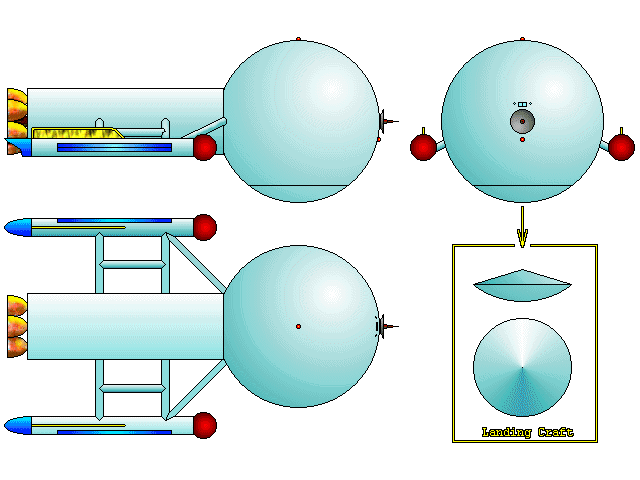
Ptolemy
Designer: Robert C. Dunehew E-mail [email protected]

Ptolemy class
Inscription on Commissioning Plaque:
"The true adventurer goes forth aimless and uncalculating to meet and
greet unknown fate."
General Specifications:-- O. HENRY
Armaments: Two Laser cannon turrets, 1 fwd, 1 top. During the Romulan wars, the landing craft was replaced by a nuclear missile rack and an uprated fire control sensor array.
Type: Exploration Frigate (later modified to Guided Missile Frigate)
Status: 67 produced starting in 2141. Last example produced was either "Socrates" or "Aesop" (records are incomplete). Registry numbers ranged from NCC-23 to NCC-106, issued as each keel was laid, without regard to sequence. Four were lost in exploration, three went missing in action during the Romulan war, two were destroyed due to enemy action during the Romulan war, one was destroyed while testing the missile rack retrofit, one ("Pythagoras") was scrapped at the end of its service life, and one ("Thales") is preserved as a display at the museum at Alpha Centauri.
About Ship: An Intermediate design between the S.S. Valiant (Where No Man Has Gone Before, TOS) and the Deadalus class, the Ptolemy class has the older bell-shaped impulse nozzle of previous types. This is the first design to offset the warp nacelle "thrust line" from the center of gravity, a move which greatly increased warp drive efficiency.
The United Earth Space Probe Administration (UESPA) initially intended to produce only twelve Ptolemy class frigates, after which production facilities would suspend production pending the introduction of the next design (the Daedalus class was in the final design stages at this time). Production was extended beyond twelve ships when the Vulcans requested six Ptolemys to supplement their older Perseus class ships in the scientific research role. This was seen as high praise for the design, and UESPA extended production by an additional 49 examples beyond those constructed for the Vulcans.
Designed prior to the invention of transporters, the Ptolemy used a landing craft (LC) similar to the conical reentry vehicle used by the Perseus class. Closely resembling a "flying saucer", this vehicle was far more maneuverable and used less fuel than the capsule of the Perseus class. Propulsion was provided by fusion reaction motors arranged as an annular "plug nozzle". If sufficient atmosphere was available, reentry was performed along a ballistic trajectory, with an aerodynamic glide to the landing zone. The saucer of the Ptolemy class could sustain aerodynamic flight with very low fuel consumption. This allowed an exploration crew to perform low-altitude surveys of the planetary surface. Landing at more than one location to take readings and gather samples was greatly facilitated by the saucer's ability to provide multiple landings and take-offs without refueling. Four landing jacks supported the LC for hard surface landings. The LC was buoyant enough to land on any liquid surface with a specific gravity greater than or equal to liquid ammonia.
Powered by fusion reactors, the Ptolemys were fast for their day, though under-gunned. This condition was remedied at the start of the Romulan war, when many Ptolemys were equipped with a nuclear missile rack and uprated fire control sensor array. The missile rack moved the center of gravity, degrading maximum warp. The thrust axis of the impulse nozzles was realigned to preserve sub-light controllability. The saucer landing craft was eliminated by this modification and surface-to-orbit transportation had to be provided by other vessels.
The Ptolemy acquitted itself well during the Romulan wars, but the greater flexibility of the larger Daedalus class rendered the Ptolemys obsolete as explorers. UESPA scrapped one remaining "war conversion" Ptolemy (the Pythagoras) at war's end. All remaining missile carrier variants were converted back to the original Ptolemy specification. For about 10 years, the Ptolemys were used as research vessels, and were gradually phased out. Many Ptolemys were converted to merchant vessels and sold to civil concerns. Others were scrapped, as their hulls were no longer spaceworthy. The Thales is the only remaining example of the type, maintained as a walk-through display at the Zephram Cochrane Memorial Space Museum in orbit at Alpha Centauri III.
Return to the Starship Catalogue.